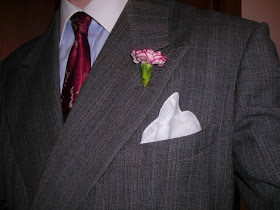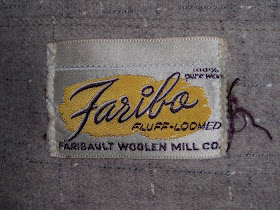The Wall Street Journal recently had an article discussing hat etiquette in today's world. If you think about it, guys nowadays either don't know hat etiquette at all or have an outdated view of hat etiquette. Let's face it, hat etiquette hasn't changed since the Golden Era but the rest of the world has.
------------------------------------------------------------------------------
Discovering Hats, a New Generation Brims With Anxiety Over Etiquette Old Rules Flummox Young Hipsters; 'I'm Wearing an $80 Fedora!'
By RAY A. SMITH
Hector Ramirez sort of knows, from watching old movies, that men are supposed to take off their hats when indoors. But the 19-year-old Brown University student wears fedoras in class—with jeans—anyway.
"If I'm wearing a hat and it's part of my look, I don't think I should have to take it off," he says. On a recent trip to New York, an usher at a church had to remind him to take off his fedora. "I was wearing it all day and I guess I kind of just forgot I had it on."
Inspired by designer runway shows, celebrities such as Justin Timberlake and even, in some cases, old pictures of Frank Sinatra, more young men are going mad for hats. But the hat renaissance is creating a quandary for a generation of men and boys who grew up without learning hat-wearing etiquette from their fathers. Many are making up their own rules about when and where to take them off.

The trend may be old hat to hipsters in areas like Williamsburg, Brooklyn, who started wearing fedoras, rounded derby hats and, in warmer weather, straw hats, more than two years ago. But now hats are starting to catch on among some men in suburbs, the Midwest and beyond. Gap and J. Crew say they have witnessed strong hat sales this spring and summer while department stores like Barneys New York have been expanding their assortments after years of general indifference to hats. Sales of designer-brand "blocked" hats such as fedoras and straw hats in particular "are definitely robust," says Jay Bell, a vice president at Barneys.
It's a bittersweet turn of events for hatmakers, who witnessed their business fall off a cliff in the 1960s, when legions of men abandoned wearing hats.
Many companies are no longer around to see the current revival. The number of manufacturers of fur-felt hats, wool-felt hats and hat forms in the U.S. totaled 185 in 1947, according to the Census Bureau. Now there are only three big hatmakers in the U.S. making fur-felt hats and wool-felt hats, says Jack Lambert, a former vice president of the Headwear Association.
Just 20% of hats sold in the U.S. are made in the U.S versus 90% in the 1940s, estimates Mr. Lambert, who is vice president of headwear company Dorfman Pacific.
In the 1930s, '40s, and parts of the '50s, a man wasn't considered fully dressed unless he had a hat on. But by the 1960s, hat wearing fell off, partly as a result of longer hairstyles, cars with lower roofs and resistance from some World War II vets who didn't want to wear things on their heads after wearing helmets for so long.
John F. Kennedy's habit of not wearing a hat was seen as the final blow for hat wearing.
Today, confusion over the rules of hat wearing is leading to some awkward situations.
Eric Soler of Hackensack, N.J., took offense when he tried to enter a bar in Hoboken recently with a fedora atop his head, only to be told there was a no-hat policy.
"It just floored me," says the 38-year-old. "I said 'I'm not wearing a baseball cap or a ski hat, I'm wearing an $80 fedora!' He grudgingly obliged and held the hat in his hand all night.
The fashion trend has prompted some rethinking of indoor hat etiquette at the Emily Post Institute. Spokeswoman Lizzie Post, the great-great-granddaughter of Emily Post, says it is now OK if a man is wearing a hat at a bar or nightclub as part of his style. "In that kind of situation, I'd feel cool with it," she says.
But when being introduced to someone, "that's when I'd remove the hat or maybe tilt it back a little so the brim isn't in your eyes and the person can see your face," she says. "It really comes down to people like making eye contact during an introduction and a hat can sometimes block that."
Several students at Lycee International de Los Angeles in Los Angeles started wearing pageboy hats and fedoras to school in the past year. When reminded of the school's dress code barring hats in the building, some students became defensive about why they should be allowed to keep them on.
"Responses range from complaints that their hair is messed up, that it is part of their outfit, it doesn't affect their work, et cetera…" says Sarah Davis-Weyman, an elementary English teacher at the school's Los Feliz campus. "Most of the time, the kids rush to put their hats back on for recess and lunch."
Sometimes, students are in too much of a rush. Harper Rubin recalls getting into a little "incident" with Ms. Davis-Weyman, who reprimanded him when he put on his hat in the hall as students were lining up to go outside.
"I didn't totally agree with that," says the 11-year-old, who admits he made a big deal out of it. "I know you take your hat off inside but I didn't think it went that far," he says.
Other guys base decisions on whether to remove their hats on how classy a joint is. Luis Quaresma, of San Jose, Calif., who likes wearing fedoras, says "If I'm going for fast food, I'll leave it on. If I'm having a nice sit-down dinner, I'll take it off." When out at a party or club, the 30-year-old says, "I don't take my hat off unless girls want me to take it off."
Some younger men do follow the traditional rules of indoor hat etiquette but it isn't always appreciated. "It came back crushed," recalls 30-year-old Vasabjit Banerjee, of the fedora he turned over to the coat check at a restaurant a little over a year ago.
The general decline in hat wearing led to the demise of proper hat racks in restaurants and bars. Mr. Banerjee, who lives in Bloomington, Ind., says he now puts his hats on a chair beside him or on the table when in restaurants.
link






















































